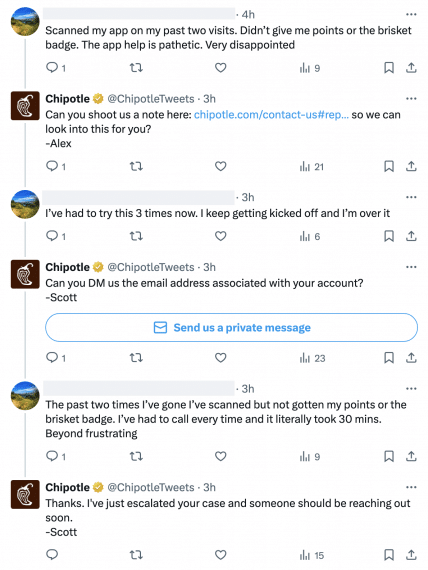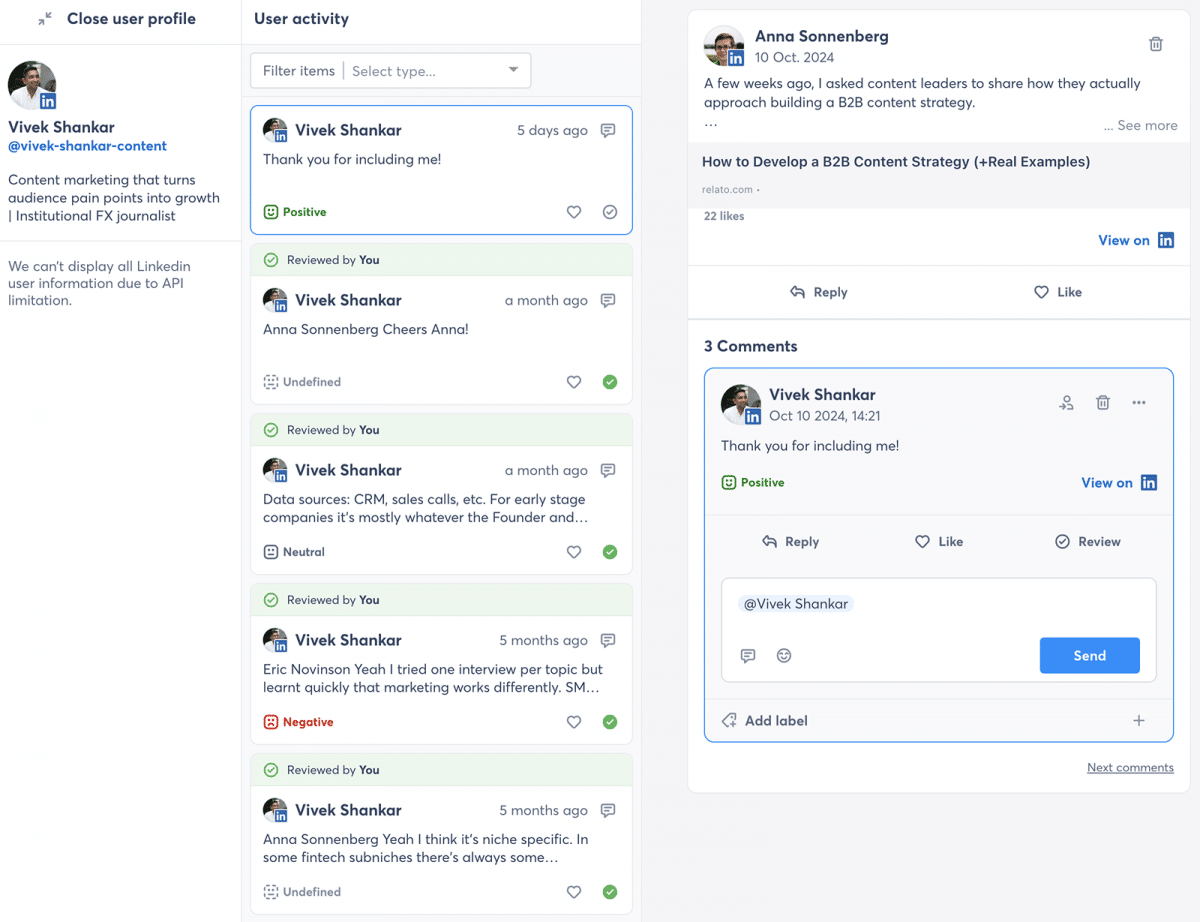For successful social media agencies, building client brands is about much more than scoring quick wins or one-off sales. Instead, agencies make the biggest impact by focusing on connecting with client audiences and creating long-lasting customer loyalty.
From LinkedIn and Facebook to TikTok and Instagram, developing delightful customer experiences is key. After all, nine out of 10 people are open to paying extra for a customer experience that makes them happy.
In this article, we’ll cover how to create branded customer experiences on social media, including tips for providing customer service, personalizing interactions, and building an engaged community.
Managing branded customer experiences for multiple clients is simpler with Agorapulse’s social inbox, publishing tools, and social listening dashboard. Sign up for a free trial to try our social media management solution for 30 days.
Understand the Customer Journey
The first step to building a brand is understanding the customer journey and the content that maps to each stage. While the stages are relatively standard, the touchpoints and channels will be unique for each client.
Map the customer journey on social media
Turning a client’s customer base from casual followers to loyal customers doesn’t happen overnight. To make the process go more smoothly, map out the customer journey.
High-performing marketing teams are 8.8 times more likely to adopt a customer journey strategy and meet customers where they are.
A typical customer journey map includes these stages:
- Awareness: Introduce clients’ products and services to new prospects via brand-aligned content.
- Consideration: Encourage prospects to consider a conversion via social proof and real reviews.
- Purchase: Secure the sale by sharing comparison content or irresistible offers.
- Retention: Invite customers to make subsequent purchases by providing delightful experiences.
- Advocacy: Turn customers into brand advocates via loyalty programs and special offers.
Identify essential channels and touchpoints
Once you’re clear on these stages, identify the touchpoints that guide prospects to the next one. What makes potential customers aware of your clients’ brands? What prompts them to make the first purchase?
To find each client’s touchpoints, review their social media and website analytics. Here are a few questions to ask:
- Which social media posts lead to the most new followers? These are awareness touchpoints.
- What kind of content gets prospects to return to your pricing or product pages? These are consideration touchpoints.
- What kind of content prompts customers to place their first order? These are purchase touchpoints.
Pay attention to the channels where each touchpoint takes place so your team knows where to invest their efforts.
For example, you might find that customers find your client’s brand on TikTok, thanks to its recommendation-powered algorithm. But you might find that customers typically purchase from links posted to Facebook.
Create Consistent, Authentic Content
Now that you know which touchpoints and channels offer the most value, it’s time to focus on creating impactful content.
Define your brand voice
To make client content stand out in the feed and fuel the customer journey, it has to be distinct. To define and develop a brand voice, you need to know what’s relatable for your audience.
For example, Salesforce, a B2B software company, uses a professional tone in social posts. As this LinkedIn post shows, the brand voice is straightforward and includes a clear call to action.
In contrast, Hilton, a hotel group, uses a casual, friendly tone in B2C social posts. As this TikTok video shows, the brand voice references popular culture and reflects the voice of the customer.
To make client brands recognizable, they also need consistent messaging and visual cues. Tone and design guidelines help keep branding consistent, whether your team tends to create unique content for each channel or you repurpose content between channels.
Build trust through authenticity
One of the best ways to build trust with prospects is to invite them behind the scenes and tell genuine stories. Showcasing company culture, telling staff stories, and building in public all help connect brands with prospects.
For example, Design Hotels shares fascinating stories from hotel owners. This Instagram post introduces the woman behind the hotel and allows her to tell her story in her own words.
In many cases, customers can add another layer of authenticity to clients’ brand stories. To encourage customers to contribute, make it easy for them to share user-generated content (UGC).
For example, Comfort Clothes regularly reposts UGC from customers. This Instagram post highlights customer content and encourages others to tag the brand to get featured.
Publish engaging content
Another way to build a rapport with customers is to publish engaging content regularly. Here are a few ideas:
- Educational content, such as tutorials and tips
- Storytelling content, such as the brand’s history
- Interactive content, such as polls and quizzes
- Emotional content, such as inspiring stories and community shout-outs
No matter your clients’ posting frequency, Agorapulse can help you schedule and publish content more efficiently.
Need to cross-post content to multiple social channels? Create the post once and select all the profiles where you want to cross-post.
Then, customize the content to fit each channel. You can adjust the copy and creative or use channel-specific features like turning an X post into a thread or scheduling the first comment on a Facebook post.
Plus, your agency team can easily loop in social media clients to review content. With our shared calendars, clients can view, approve, or request edits for all drafted, scheduled, and published content.
Provide Customer Support via Social Media
Publishing memorable content is just one aspect of creating a branded experience. It’s just as important to respond to follower engagement and customer inquiries.
Establish a customer service framework
First, decide how and where your team will provide customer service. Will you have a dedicated support channel?
For example, Verizon has a dedicated support profile on X. When customers engage with other branded profiles, Verizon Support responds to address the situation, as this X conversation shows.
For more sensitive issues, you may want to encourage customers to send the brand a DM. In some cases, it might make more sense to take the conversation off social media and loop in the brand’s customer support team.
For example, Chipotle typically directs customers to the brand’s contact form to submit inquiries or complaints. But for more personalized service, the team encourages DMs, as this X exchange shows.
In addition to deciding on channels, define support hours and clarify how quickly your team will respond. Keep in mind that 20% of American social media users expect an immediate response, and 24% expect a reply within an hour.
Respond to customer feedback and inquiries
It’s easy to focus customer service frameworks on negative exchanges. After all, about 30% of customers will stop interacting with brands they love after a single bad experience.
But it’s equally important to invest energy into positive exchanges and cultivating relationships with each client’s customer base. For example, this Instagram post shows how Olipop makes a habit of replying to comments.
Can’t reply to every single comment your clients receive on social media? It’s in your team’s best interest to prioritize answering questions and responding to feedback.
Agorapulse helps agency teams handle overflowing inboxes faster. With our social inbox, you can set up saved replies for each profile. This way, you can easily respond to common questions and concerns without having to type the same reply from scratch or copy and paste it from another app.
However, you don’t have to reply with the same boilerplate response every time. Instead, use saved replies as the foundation of your message. Then, add personal notes or details to go beyond generic.
Personalize the Customer Experience
Customizing experiences adds much more value than you might think.
Nearly 80% of business leaders report that personalized interactions cause consumers to spend more.
Here are some simple ways to add personalization.
Refer to past conversations to tailor interactions
Interacting with a new prospect requires a different approach from engaging with a longtime customer. When a new prospect reaches out for the first time, your team might provide a general response or ask a few questions to gather basic information.
But when a loyal customer comments on your client’s latest post, you can go the extra mile by referencing past interactions. This approach essentially continues the conversation and makes the customer feel more valued.
With Agorapulse, it’s easy to incorporate data from past touchpoints. Every time a social media user comments on your client’s posts or sends a DM, our platform keeps a running tally of each interaction.
When you go to reply to a comment or DM, you can open the user profile to see the previous interactions and reference them in your response. Plus, your team can leave internal notes for added personalization.
Plus, Agorapulse integrates with CRM software like HubSpot and Salesforce. This way, your team can automatically record touchpoints and update prospects’ records after every social media interaction.
Set up social listening tools
Just because a prospect comments for the first time doesn’t mean you don’t have any context for their situation. When you use social listening tools, your team can keep a finger on the pulse of conversations about client brands.
For example, suppose several customers recently raved about the client’s newest product launch. Or say several customers have complained about the client’s new guest policy.
With Agorapulse’s social media listening tool, you can automatically stay on top of this kind of conversation. Once you set up a listening search for the client’s brand name, keywords, and hashtags, you’ll create a feed with all relevant content from across social media and the web.
Our social listening tool automatically monitors customer sentiment to help you understand if the conversation is positive or negative. It also tracks engagement trends and search volume so you can see how many people are talking about your client’s brand.
Plus, you can view and engage with all of the conversations about your client. This means you can create additional touchpoints and capture additional opportunities to create a branded customer experience.
Build Community and Foster Engagement
Another way to delight customers is to welcome them to an engaged community. Here are a few ideas for cultivating a community and fostering engagement.
Encourage testimonials and UGC
Are your social listening searches failing to turn up many testimonials or UGC? Take a proactive approach and invite customers to create content featuring your clients’ brands.
- To collect more UGC, consider running a contest. Create a branded hashtag and encourage customers to create content around a theme.
- To get more reviews, ask. The next time you share a great testimonial for your client’s brand on social media, encourage followers to share their thoughts via a comment, DM, or review.
Each time you share UGC or a customer review, you create social proof, which can be surprisingly powerful. Social proof can nudge prospects from the consideration to the purchase stage, as it helps guide people’s actions.
Engage with followers in real time
While there’s nothing wrong with asynchronous engagement, real-time interactions often do a better job of making customers feel like they’re part of a community.
One way to engage synchronously is to respond to customer comments almost immediately. For example, after posting client content, consider taking 15 minutes to engage with customer comments in real time.
Another option is hosting interactive events that allow followers to ask questions or share feedback—and get instant responses. For example, consider working with your clients to go live, host ask me anything (AMA) sessions, or create webinars.
Create exclusive groups or communities
Public comments and posts are great. But when you want to create a more exclusive space for customers, set up a group.
Facebook and LinkedIn groups are ideal for fielding feedback and deepening customer relationships. You can also use these spaces to reward loyal customers by sharing exclusive information.
For example, Olipop Nation is a private Facebook group where customers are welcome to share feedback, learn about new products, and celebrate the brand.
Measure the Impact of Your Brand-Building Efforts
How well are your brand-building efforts working? Take time to review social media metrics regularly and adjust your approach as necessary.
Essential metrics to track customer experience on social media
To evaluate the success of your team’s efforts, consider a few different angles.
First, look at engagement rates. It reveals how well your content resonates with clients’ followers by measuring their likes, comments, and shares based on the total impressions.
Agorapulse also charts different types of engagement so you can see whether followers are liking, commenting, or sharing. Plus, our comparative metrics show how your engagement evolves over time.
Next, check your clients’ sentiment scores. This metric reveals whether conversations about your brand are positive, neutral, or negative. The comparative metric shows how this metric has changed from the prior period.
Agorapulse also charts sentiment scores by day. This way, you can easily spot days when sentiment dipped or spiked so you can determine the root cause.
Finally, review response times and resolution rates. This metric keeps your team accountable, as it tracks how quickly you respond to comments or DMs. It also tallies the number of replies your team has sent.
Agorapulse charts replies by the day so you can quickly spot unusual activity levels. Our reports also show how much each team member contributed to community management.
Adjust your clients’ social media strategy based on data
Once you have clients’ social media reports in hand, assess the impact of your team’s work. Here are a few questions to consider:
- How quickly did your team respond to comments and DMs? Is it possible to respond faster? What would it take for your team to speed up response times?
- Is customer sentiment steady or increasing? Can you take steps to address negative issues? How can you proactively improve each client’s sentiment score?
- Are engagement rates steady or increasing? How can you increase engagement rates? Do you need to revisit your content plan or your engagement plan?
Use your responses to these questions to adjust your clients’ strategies. In some cases, you may be able to get by making minor changes to your messaging or response rate.
In other cases, you may need to make more drastic changes to get ahead of negative issues or double down on positive interactions. These adjustments may require revisiting your budget or partnering more closely with clients.
Next Steps to Create Better Branded Customer Experiences
Between brand-building and providing memorable customer experiences, your agency can create tremendous value for clients. In addition to cultivating a loyal community, your team can attract customers who are happy to spend more for a positive experience.
Whether you’re managing a few or several dozen clients, Agorapulse helps agencies handle everything from publishing and engagement to listening and reporting. Sign up for a free trial for your team today.





















